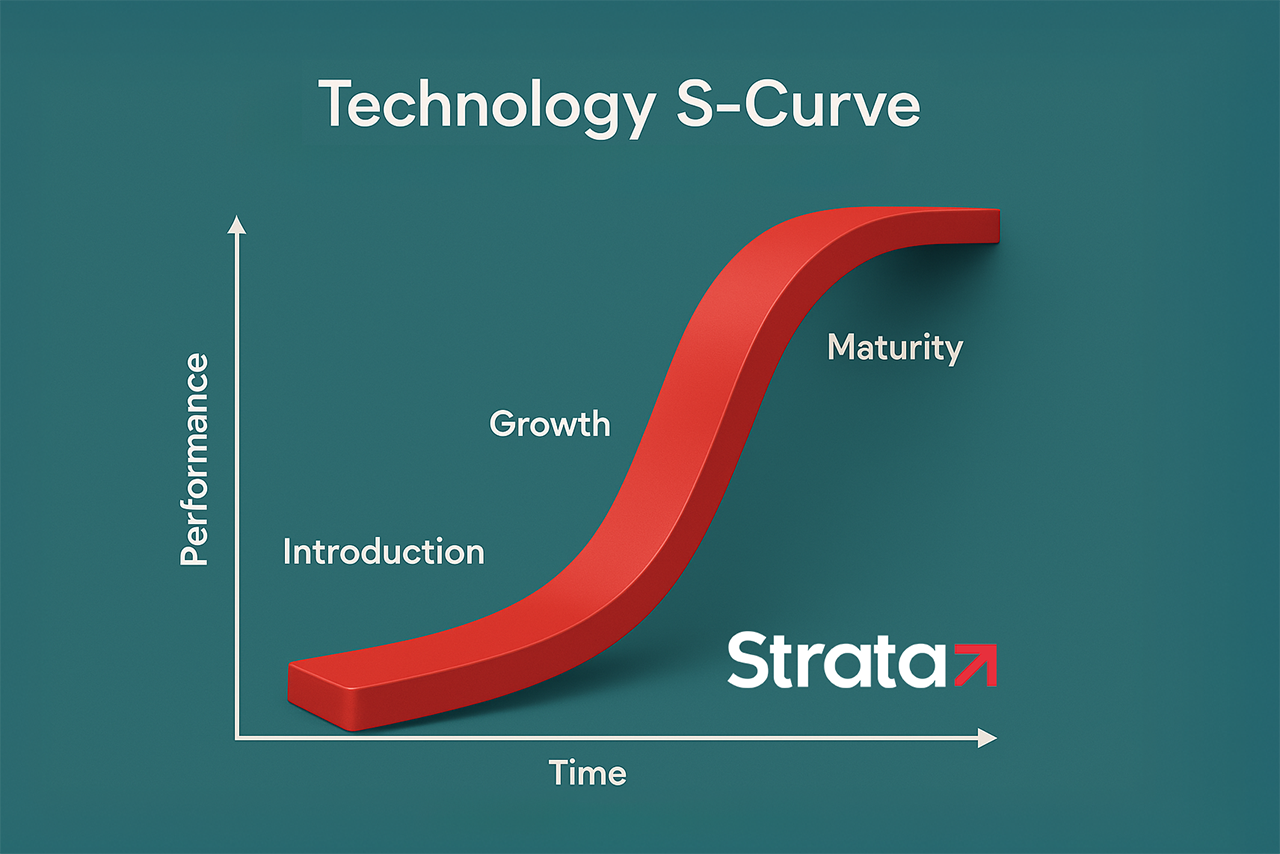Understanding Innovation & Industry Transformation
The evolution of technology follows a predictable pattern known as the S-curve. This model is valuable in understanding the lifecycle of a product, from its initial introduction to its inevitable decline. This concept is not only applicable to technology but also mirrors the natural progression of individuals’ careers and lives.

The S-Curve in Technology Evolution
When a new product is introduced, such as the DVD player, sales typically start slowly as consumers struggle to recognise its benefits. However, as advertising efforts increase and early adopters showcase the product’s advantages, sales begin to grow. This phase attracts competitors who introduce their own versions, further expanding the market (Potts and Evans, 2008).
As Foster (1986) argues, every technology has physical limits. Once a product reaches its peak in performance and consumer adoption, growth slows down, leading to market maturity. In an effort to extend the product lifecycle, companies may pursue incremental innovations – such as the introduction of Blu-ray DVDs and smaller DVD players (Henderson and Clark, 1990a). However, these efforts only provide short-term competitive advantages. Ultimately, sales decline, and companies must decide whether to discontinue the product.

The Role of Radical Innovation
Christensen (1997a) highlights the predictive value of the S-curve, suggesting that once a technology matures, a successor is often on the horizon. This leads to the concept of ‘technology push,’ where new advancements drive the next wave of innovation (Henderson and Clark, 1990b). The transition from DVD players to streaming services exemplifies this shift. The development of internet infrastructure enabled companies like Netflix to offer personalised content directly to consumers. The ability of firms such as Netflix and Amazon to deploy thousands of servers and terabytes of storage in short periods of time (Venkat Venkatraman, 2017) ultimately led to the demise of the DVD player.
Lessons from the Sony Walkman
Smith (2015) explains that technology performance improves over time but ultimately reaches a ‘natural limit.’ This pattern is evident in the history of portable music devices. Sony launched the Walkman in 1979, but initial sales were slow, with the first 30,000 units taking over three months to sell (Ikuo, 2019a). However, by October 1982, 5.5 million units had been sold, demonstrating the rapid growth phase of the S-curve.
Despite its success, Sony recognised that cassette technology would eventually mature. In response, the company developed the Discman, a portable CD player, which was released in 1984 – just as cassette demand peaked (Ikuo, 2019b). This strategic move showcased Sony’s ability to anticipate technological shifts. However, as Christensen (1997b) warns, even industry leaders can miss key transitions. While Sony successfully introduced the Minidisc Walkman in 1992, it failed to foresee the rise of digital music in the early 2000s, losing ground to MP3 players and, eventually, streaming services.
Applying the S-Curve to Personal Growth
At Strata, we believe that the S-curve is not limited to technology; it also applies to personal and professional growth. People too go through chapters in life where they experience slow growth, rapid development, and eventual stagnation. Recognising when one has reached a plateau and embracing new opportunities can be the key to sustained success. Just as companies must anticipate and adapt to technological change, individuals must be open to learning, upskilling, and reinventing themselves.
Conclusion
The S-curve provides a powerful framework for understanding technological evolution, industry shifts, and even personal development. Whether considering the decline of DVD players, the rise of streaming services, or the transformation of the music industry, the same pattern emerges. The key to sustained success – both for companies and individuals – is recognising the signs of maturity and being prepared to embrace the next wave of innovation. Strata Professional Development can support businesses, individuals, and organisations in navigating their S-Curves by supporting them to develop their leaders through an offer of needs analysis, coaching, and carefully crafted training. Please get in touch to find out how we can support you.
References
Christensen, C. M. (1997a). The Innovator’s Dilemma: When New Technologies Cause Great Firms to Fail. Boston: Harvard Business School Press.
Christensen, C. M. (1997b). The Innovator’s Dilemma: When New Technologies Cause Great Firms to Fail. Boston: Harvard Business School Press.
Foster, R. J. (1986). *Innovation: The Attacker’s Advantage*. New York: Summit Books.
Henderson, R. M., & Clark, K. B. (1990a). Architectural Innovation: The Reconfiguration of Existing Product Technologies and the Failure of Established Firms. *Administrative Science Quarterly, 35*, 9–30.
Henderson, R. M., & Clark, K. B. (1990b). Architectural Innovation: The Reconfiguration of Existing Product Technologies and the Failure of Established Firms. Administrative Science Quarterly, 35, 9–30.
Ikuo, S. (2019a). Walkman Story: The Early Years of the Iconic Personal Cassette Player. Nippon.com. Available at: [https://www.nippon.com/en/japan-topics/g00726/walkman-story-the-early-years-of-the-iconic-personal-cassette-player.html] (https://www.nippon.com/en/japan-topics/g00726/walkman-story-the-early-years-of-the-iconic-personal-cassette-player.html)
Ikuo, S. (2019b). Walkman Story: The Early Years of the Iconic Personal Cassette Player. Nippon.com. Available at: [https://www.nippon.com/en/japan-topics/g00726/walkman-story-the-early-years-of-the-iconic-personal-cassette-player.html] (https://www.nippon.com/en/japan-topics/g00726/walkman-story-the-early-years-of-the-iconic-personal-cassette-player.html)
Potts, W., & Evans, B. (2008). *Design and Technology: Product Design (3D Design)*. London: Nelson Thornes.
Smith, D. (2015). *Exploring Innovation* (3rd Ed.). London: McGraw-Hill.
Venkat Venkatraman, N. (2017). Netflix: A Case of Transformation for the Digital Future.
